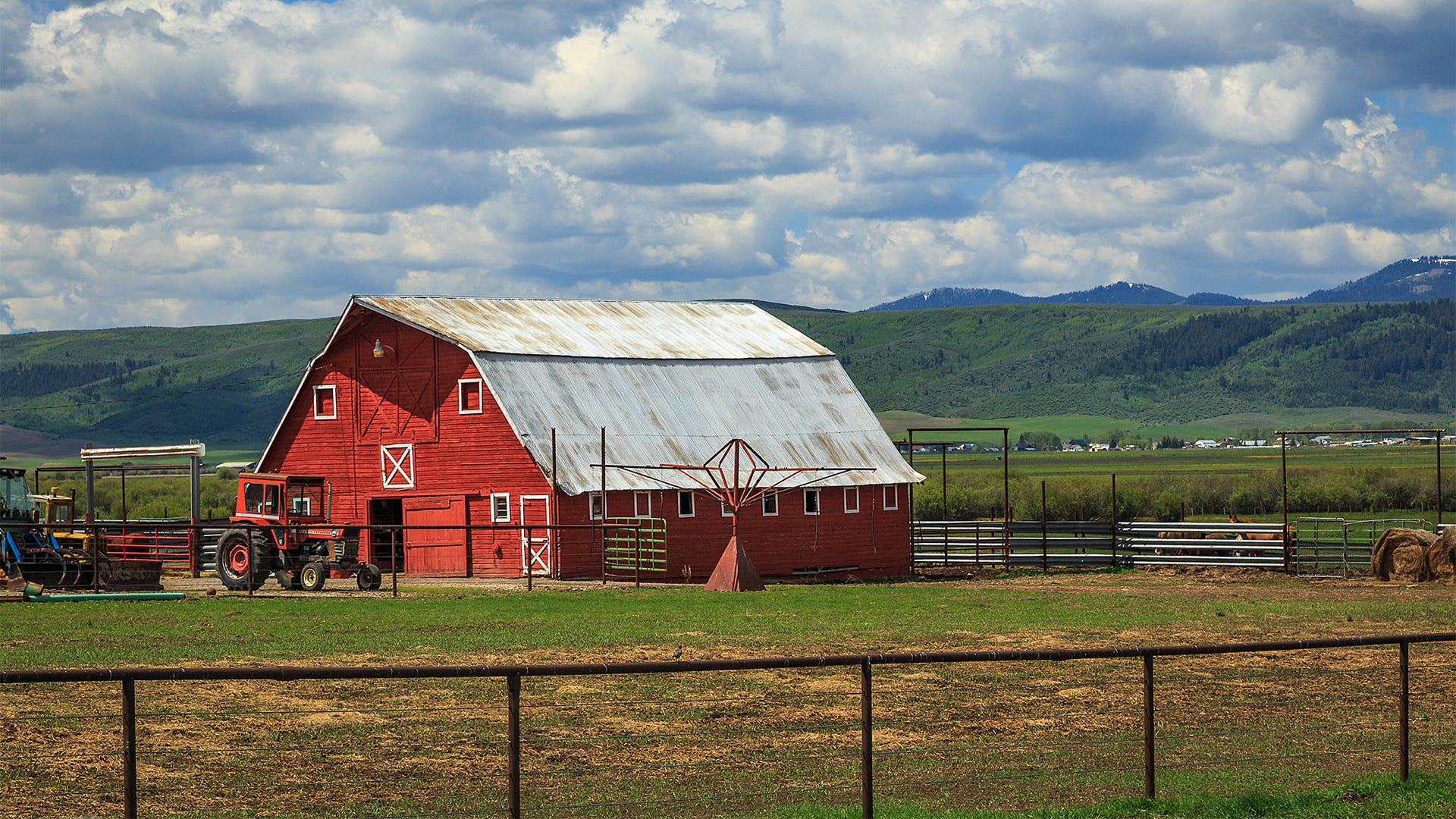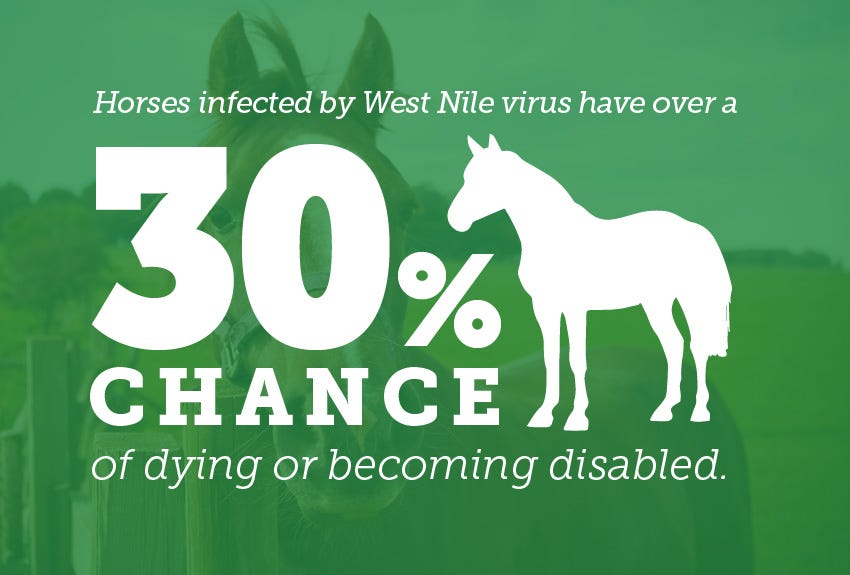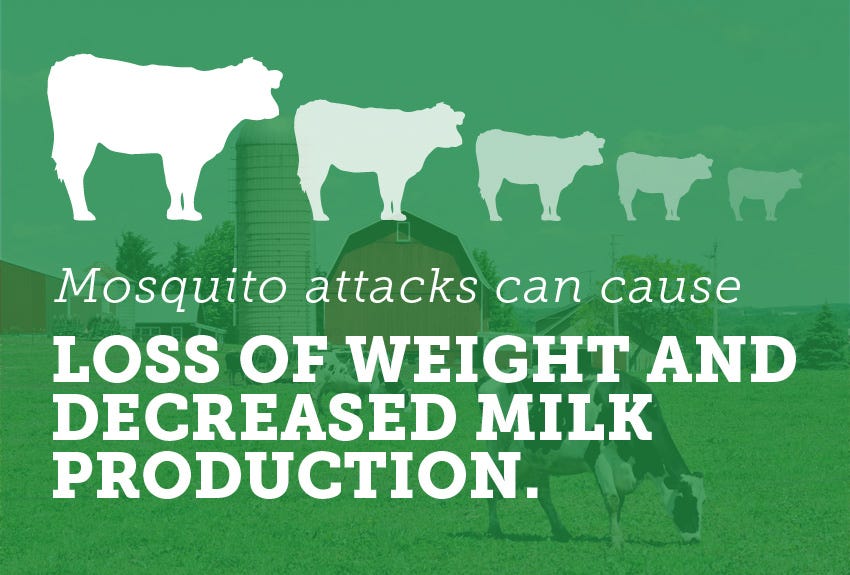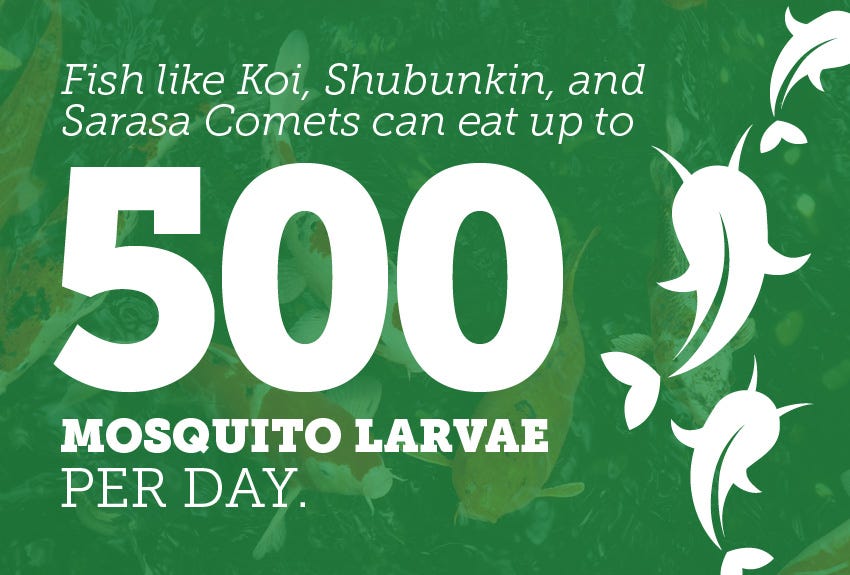
Americans have come to rely on a food supply that is abundant, affordable and safe. These are guarantees provided by an efficient network of more than 2 million farms, 97 percent of which are operated by families.
Protecting America’s farmland from mosquito-borne disease is crucial to ensuring the continuity of the food chain. Mosquitoes are more than a nuisance on the farm; they are a threat to the very health and livelihood of it.
Not only do mosquitoes carry dangerous diseases, but they also don’t discriminate between cows, horses, goats, humans or any other warm-blooded creature that exhales carbon dioxide. All are potential targets on what are traditionally fertile grounds for these pesky creatures.
The Importance of Farm Mosquito Control
Mosquito-borne disease represents a threat to livestock across the country. Agriculture operations rely on clean and healthy animals to be able to provide the safe and delicious food that Americans count on day in and day out.
Livestock mosquito control is so important because animals that are constantly badgered by mosquitoes will not feed properly. It’s not uncommon for cows and goats to provide less milk while cattle, sheep and poultry may suffer weight loss. Mosquitoes transmit viruses that cause encephalitis in horses and myxomatosis in rabbits.
It’s impossible for agriculture to occur without water, and the same is true for mosquitoes. Today’s modern farming operations, filled with acres of land, machinery, buildings and vehicles, typically create perfect microenvironments where mosquitoes can survive and breed.
Knowing that mosquitoes are a potential problem is the first step in avoiding the scourge. There are ways that today’s farming operations can effectively mitigate mosquito risk.
Mosquito Control for the Farm
|
Three Basic Principles |
|
Ensure the prevention or elimination of wastewater that has been standing for more than four days.
|
| Keep the property irrigated so that there is no surface water standing for more than four days. |
| Properly maintain the area around ponds, ditches and shallow wetlands. |
Any standing body of water represents the perfect spawning ground for mosquitoes. They thrive in ponds, ditches, fields and containers. Old tires, birdbaths, clogged gutters, garbage can lids and even pet food bowls can all prove to be welcome mosquito breeding grounds if not properly flushed out. Permanent natural bodies of water, such as ponds or wetlands, don’t always represent good environments for mosquitoes because of the presence of predatory insects and fish. Conversely, very weedy and shallow waterways that receive a fair amount of excess runoff from fertilizers or manure can be havens for mosquitoes. Prevent such runoff through proper drainage, minimal fertilizer use, and buffer zones between open fields and wetlands. By controlling weeds, natural predators can more effectively hunt mosquitoes. Natural streams also tend to create stagnant pools as they weave their way through the property. Here some ways to keep Mother Nature from getting in the way of good mosquito control:
- Ensure that rushes and cattails are thinned and that old leaves are not piling up.
- If shallow wetlands are a problem, mow them down during the dry season.
- If a stream is forming stagnant pools, dig small ditches to connect the stream to the pools.
Coastal farms must also be vigilant to avoid standing water created by tides or rain. This problem can be effectively managed by digging ditches that assist in drainage once the rain ceases or tide falls. In some cases a levee with a tide gate will keep out the high tide salt water while fresh water flows out when the tide recedes. Here are some additional considerations when creating a farm mosquito control plan:
- Maintain Impoundments: Impounded water is a great place for mosquitoes to breed, unless the proper steps are taken to maintain them. Properly grade the sides and bottom, prevent overgrown vegetation and stock it with insect-eating fish.
- Drain Field Ditches: Any ditch that could end up holding water for more than four days is a potential mosquito breeding ground. Try plowing in any field ditches following irrigation.
- Fix Structures: A leaky head gate or turnout structures could potentially create pools of stagnant water. When constructing or renovating these buildings, make sure that water cannot escape around or under the structures. Any gate must fit well enough that water does not escape.
- Keep Up Road Conditions: Even the smallest pothole or road rut can be welcoming to mosquitoes during warmer weather. These waters contain few to no predators and may be on roads that don’t often seen traffic. Also keep roadside drainage areas and ditches clear of debris or blockage. Storm water should be effectively drained to prevent stagnation.
- Use Different Lighting: There are multiple sources of light on any farm. Since mosquitoes are attracted to light, this potential liability can be turned into an advantage. Beyond dimming or turning off lights, there are specific types of lights that can be used to help ward off mosquitoes. Yellow incandescent or fluorescent lights in the barn or stable provide a much less attractive target for mosquitoes.
- Watch for Tree Holes: The western tree hole mosquito relies on rain water that accumulates in tree holes to develop its larvae. Tree holes can be found in old orchards as well as landscape and wild trees. To avoid disturbing potential bird habitat in the summer months, try drilling a simple hole at the bottom of the tree hole.
- Set Traps: Let’s face it: Some farms are large and it isn’t always easy to spot every single pool of stagnant water. There may be instances where mosquitoes are breeding on the property. Keep the ones that manage to live at bay by setting traps.
- Utilize Return Flow Systems: Ensuring that wastewater is reused is not just more efficient and economical, it also helps to reduce the mosquito population. Excess water pools in a sump at the lowest point of the field. A low-lift pump then moves the water into a pipeline that delivers it back into the irrigation system. By reusing the wastewater any fertilizer is reused, reducing the need for more. These are just a few irrigation techniques for controlling mosquitoes. Ensuring the surrounding farmland and associated buildings are not laying out the welcome mat for mosquitoes is only half the battle. Where there are animals, there may be mosquitoes. Fortunately, there are animal-specific techniques that can help keep the bloodsuckers at bay.
Mosquito Control for Horses

It’s a sobering thought that these tiny insects can cause very serious problems for a 1,000-pound horse. They represent more than just an annoyance. Protecting horses from mosquitoes is especially important considering there are four different mosquito-borne viruses that can devastate the horse brain:
- Eastern Equine Encephalomyelitis (EEE)
- Western Equine Encephalomyelitis (WEE)
- Venezuelan Equine Encephalomyelitis (VEE)
- West Nile Virus (WNV)
There’s been a huge jump in West Nile Virus alone since 2000, when the first case was identified in the northeastern United States. It took only two years for the virus to make its way across the contiguous 48 mainland states. There are vaccines that are quite effective in preventing infection by any of the major mosquito-borne equine diseases. In addition to vaccines, however, there are techniques that horse owners can utilize that help to limit mosquito breeding grounds:
- Stagnant Water: It may seem like we’ve heard this one before, but it’s always the most important. The first step in effective mosquito control is always draining and eliminating standing or stagnant water. If the horses are hydrating through a watering pond or trough, it is important to ensure those drinking sources are properly flushed and kept clear of weeds and overgrowth.
- The Stable Area: The stable area is where horses are most sedentary and susceptible to mosquito bites. Ensure damp vegetation is removed and that any areas of standing water are flushed out or filled in. Stable and barn mosquito control is especially important considering this is where the animals spend most of their time.
- Circulate Air: Stagnant air can be just as dangerous as stagnant water. Unmoving air traps moisture and pleasing mosquito scents like manure and garbage. Try installing fans throughout the barn or stable to keep mosquitoes on the move.
- Pasture Turnout: Evening pasture turnout is especially popular in the warmer months. Unfortunately, mosquitoes are most active between dusk and dawn. Avoid nighttime pasture turnout whenever possible, especially in areas that are near water sources.
- Pasture Irrigation: Be sure to drain the pasture of any excess water within 24 hours of an irrigation. Doing this ensures scalding and weeds are reduced. Ensure that slopes are graded for proper drainage. A drainage ditch at the lower end can also reduce unwanted standing water spots. Beyond the seemingly simple act of a mosquito transmitting a deadly virus, effective horse farm mosquito control prevents these majestic animals from damaging themselves and the property. Horses have been known to react violently to mosquito swarms. Some swarms can get large enough to cause a horse to quite literally barrel right through pasture fences. Hoof damage can also result from horses continually stomping the earth in response to flies and mosquitoes. Both colic and disrupted feeding habits remain a danger in the presence of incessant mosquito swarms. Beyond horses and drainage ditches, many modern farms also have livestock concerns. Where do cattle, chicken and goats fit in to mosquito prevention?
Mosquito Control for Livestock

While it is true that horses and wild birds are most at risk from mosquitoes, livestock such as cattle and chickens are also vulnerable. Animals gathered in one area, perhaps around a body of water, provide fertile breeding ground for mosquitoes. Try the following steps to ensure that livestock is kept clear of swarm mosquitoes:
- Periodically inspect the fields for drainage or areas that need to be releveled or refilled. There are often small areas of standing water that can be filled in by hand.
- Ensure animals stay off the pasture when the soil is very soft. Livestock hoofs create the perfect mosquito habitat when they imprint into the soft earth. Allowing the soil to harden before releasing the animals into the pasture not only prevents mosquito habitats, but also protects the roots of the forage crop.
- Keep the fields rotated so that each pasture can dry and grow between irrigations and grazing. Do this by breaking up the large pasture area into a number of smaller fields. This practice also helps to prevent hoof damage, increase irrigated pasture production and promote a healthier root system, allowing for better water penetration.
- Don’t use excess fertilizer, which can seep into irrigation water and promote mosquito production in ditches and standing pools further downstream. Mosquito control for chickens, goats or any other farm animals will be relatively the same. As with horse stables, farms and barns, ensure chicken coups are equipped with lighting that repels mosquitoes and flying insects. Keep air circulating and always be on the lookout for standing water.
Biological Mosquito Control

Insects always prove to be delicious snacks for creatures above their station on the food chain. In many cases it is just a bigger, badder bug that ends up enjoying a mosquito meal, though there are plenty in the animal kingdom that also put mosquitoes on their menu.
For insect control, try dragonflies. Dragonfly nymphs are dangerous to mosquitoes in both stages of life. They eat mosquito larvae in their nymph stage, then also feast on the adults after they themselves transform. Drop the nymphs into ponds or other bodies of water that are kept clear of weeds.
Though a population of live bats may be harder to come by, any nests of them around the farm should be welcomed for their mosquito-eating tendencies. Bat houses or bat caves can also be constructed to attract the mosquito-eating creatures. Contrary to popular belief, mammals have more to fear from a bloodsucking mosquito than a bat. Very few bat species around the world actually suck blood.
Perhaps the most efficient biological mosquito-control agents are mosquito-eating fish. Fish like Koi, Shubunkin, and Sarasa Comets can eat up to 500 mosquito larvae per day. As always, before stocking check with the local fish and game department regarding local regulations.
Mosquito Control Considerations
Insect control can seem like a daunting task, not the least of which is because of their resilience throughout the seasons. Managing this problem while running a farm also presents a unique set of challenges.
Though chemicals, foggers and larvicides are an option, open land, vegetation and large areas of livestock present a complication. While some biological agents target only mosquito larvae, others can potentially be toxic to crops or livestock. Jurisdictional considerations come into play as some municipalities approve of limited forms of chemical control.
There are also land considerations when farmers consider changing the configuration of the property or adjacent lands to prevent mosquito breeding ground. If wetlands adjacent to the farm are fertile mosquito breeding grounds, be mindful that some wetland vegetation is protected. There are, however, several types of alterations that can help reduce the mosquito population without damaging the natural environment. As always, consulting the local municipality is essential to ensuring no laws are broken or protected land altered.
When considering adding mosquito-eating fish to waters around the property, invasive species rules must also be followed. In many jurisdictions it’s illegal for private citizens to introduce fish into natural waters. Fortunately, technology does offer an answer. There are devices available that can draw, capture or kill mosquitoes in a very harmless and relatively inexpensive way. When considering all of the options available for large farms already used to technological innovation, specialized mosquito traps may be the way to go.
An example of efficient mosquito trapping machines would be those that emit a harmless gas and draw the insects into a trap where they then dehydrate and die. Click here for more information on how these devices work and a side-by-side comparison of different models.
No matter how today’s modern farmer goes about eliminating ever-present mosquito threats, the fact is the threat is growing. Not only does effective mosquito control protect human, horse and livestock health and well-being, it also keeps America’s food supply chain humming along without interruption.



